
19 December 2020
As we approach the shortest day(*) of the northern year we can take heart that our days are as long as they are. 70 million years ago, in the age of the dinosaurs, the Earth spun faster than it does today. Rather than having 86,400 seconds per day to get things done, dinosaur days were half an hour shorter.
This discovery came to light when paleontologists used lasers to study the growth rings of a rudist bivalve fossil found in the mountains of Oman. During the Cretaceous period rudist bivalves lived in tropical seas and grew throughout their lifetimes, laying down new shell material every day.

The lasers were precise enough to identify four to five data points within each day cycle and see that …
The composition of the shell changed more over the course of a day than over seasons, or with the cycles of ocean tides. The fine-scale resolution of the daily layers shows the shell grew much faster during the day than at night.
— AGU.org: Ancient shell shows days were half hour shorter 70 million years ago
Thus “the growth rings allowed the researchers to determine the number of days in a year and more accurately calculate the length of a day 70 million years ago.” They also discovered information on the Moon’s formation and proximity. — agu.org
The Earth, like all of us, is slowing down with age. Every day is infinitesimally longer than the last. (It sure has felt that way during the COVID-19 pandemic!) On the bright side, even when we feel rushed we can be glad we have that daily half hour the dinosaurs missed.
Read more at: Ancient shell shows days were half hour shorter 70 million years ago.
(illustration of dinosaurs from Wikimedia Commons; click on the caption to see the original)
(*) The winter solstice is at 5:02am ET on 21 December 2020.
Interesting! From the link: